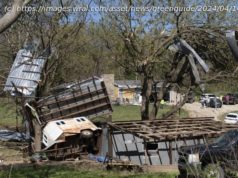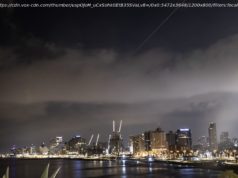The storm, expected to make landfall on Wednesday, is poised to be the most powerful hurricane to strike the mainland United States so far this year.
PANAMA CITY BEACH, Fla. — Hurricane Michael approached a fortified Florida Panhandle on Tuesday and strengthened into a Category 3 storm that is expected to make landfall on Wednesday as the most powerful tropical cyclone to strike the mainland United States so far this year.
The National Hurricane Center said that the storm had maximum sustained winds of 120 miles per hour, and would reach the Florida coastline on Wednesday. Emergency declarations were issued for parts of Alabama, Florida and Georgia, and the authorities ordered tens of thousands of people to evacuate as they opened storm shelters and shut down schools.
“Hurricane Michael is a monstrous storm, and the forecast keeps getting more dangerous,” Gov. Rick Scott of Florida said during an appearance at the state’s emergency operations center in Tallahassee, the state capital.
[ Read here for live updates on Hurricane Michael’s path and impact.]
The storm, classified as a major hurricane, is in the Gulf of Mexico, gathering still more power from the warm waters there. Weather forecasters and government officials worried about lashing winds and an onslaught of rain, but they most plainly feared the hurricane’s storm surge, which they said could reach 13 feet in some areas, in a region that is particularly vulnerable to it.
“Regardless of whether the track moves a little to the left or the right or wobbles, it’s going to be a bad storm surge event for somebody,” said Jamie Rhome, a storm surge specialist at the National Hurricane Center.
Scientists are still examining the links between climate change and storm intensity, but have observed some of the effects of global warming, particularly in increased storm surge and rainfall .
But perhaps the most interesting thing about Hurricane Michael, from a meteorological perspective at least, is its normalcy. After deeply destructive hurricanes, like Florence last month and Harvey in 2017, both of which dawdled over land and dumped disastrous amounts of rain, Michael was moving at a speed that was “almost exactly average for storms,” said Brian McNoldy, a senior research associate at the University of Miami’s Rosenstiel School of Marine and Atmospheric Science.
The storm formed in the Western Caribbean and moved steadily northward, which is typical for this time of year, and will strike in October, well before the Nov. 30 close of the Atlantic hurricane season. And the storm has moved along a path well predicted by computer models, which have suggested a Panhandle landfall for days.
“It’s a very well-behaved storm,” Mr. McNoldy said.
Predicting its consequences is harder to do. After striking Florida on Wednesday, Michael is expected to race over Georgia and the Carolinas — including communities still recovering from Hurricane Florence — as a tropical storm before moving offshore on Friday.
“Because of the damage caused by Hurricane Florence and the fact that there’s still some standing water in places, we have to be that much more alert about the damage that Hurricane Michael could do,” Gov. Roy Cooper of North Carolina said on Tuesday. “We know we have to be ready, and hurricane-weary North Carolinians cannot let their guard down just because we’re fatigued with Hurricane Florence.”
In Florida, residents rushed toward shelters, some arriving hours before they opened so they could snag a coveted spot.
Mary Thompson, 69, was among those seeking a corner spot at a shelter in Tallahassee, two years after Hurricane Hermine swept through the capital and left her terrified. This time, with her street lined with trees, she fled to a shelter where volunteers passed out bottled water and trail mix.
To the west in Fountain, the Piggly Wiggly Express market was a showcase of the other options before a hurricane: hustling out of town, or stocking up to sit it out at home.
Under cloudy skies, the air thick and hot, a pool of people waited in line at the automated ice machine. A few feet away, the gas pumps were busy with Floridians topping off as they fled from the coast and north toward Dothan, Ala. — and what they hoped would be safety.
Inside, the cashiers moved mountains: Bud Light, infant formula, potato chips, cupcakes. Zihesa Long and Tayrael Perryman were there, happy to find what they had come for — three extra-long loaves of Sunbeam bread.
Mr. Perryman, 42, of Panama City, said they had been unable to find any bread on the shelves in their neighborhood. So they drove up Highway 231, checking stores until they found it at the Piggly Wiggly.
With bread in hand, Mr. Perryman and Ms. Long, 32, were headed back to their home in Panama City, about a 30-minute drive south. They lived near a bayou, he said, which they feared would overflow with the storm surge. But they were still on the fence about leaving. The plan was to keep waiting and watching the news. If by Wednesday morning Michael still looked like it was going to slam straight into Panama City, then maybe they, too, would head to Dothan to bunk with relatives.
As he waited to buy a 20-pound bag of ice, Mike Sanville, 64, puffed on a cigarette and said that he was also going to try to ride the storm out in Fountain, in the small house he shares with two other men. He was expecting the town to get punched hard. “It’s coming right at us,” he said. “We’re dead center.”
Mr. Sanville, a retired construction worker, said he worried that the roof would blow off his house as the winds picked up Tuesday night. If that happened, he said, he might ride out the rest of the storm in an outhouse he had built out back. He said that it had survived a blow from a falling tree a few years ago.
But would all three residents fit in an outhouse? Maybe, he said. No question it would be a tight fit.
And as both the hurricane and nightfall neared, the big Florida beach towns in the storm’s sights were not yet empty. A few cars crawled down the wide boulevards off the beach, but there was a stillness to the deliriously tacky tableau that is Panama City Beach: No lines at the Ripley’s Believe It Or Not. No crab eaters at Dirty Dick’s Crab Shack. No putters on the town’s elaborate fantasias of novelty golf.






